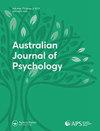运用Rasch分析法对学业动机量表进行评估与改进
IF 3.6
4区 心理学
Q1 PSYCHOLOGY, MULTIDISCIPLINARY
引用次数: 4
摘要
摘要目的28项学业动机量表(AMS)是一种被广泛使用的学生学习动机测量方法,但它存在有序量表精度低、不适合参数统计等局限性。本研究旨在利用Rasch方法评估AMS的心理测量特性,并利用序数-区间变换提高量表的精度。方法采用部分信用疹模型对429名新西兰医学生的英语问卷进行分析。结果AMS与Rasch模型的初始拟合较差,通过创建四个超级项目来改善,这些超级项目结合了相互之间具有较高残差相关性的相关子量表/项目。这些修改导致最适合Rasch模型,量表参数与模型期望没有显著偏差(χ2 (24) = 19.79, p = 0.71),性别,年龄和种族群体的不变性,单维性和高信度(PSI = 0.81)。结论本研究支持了AMS的稳健的心理测量特性,并制作了转换表,将有序的AMS分数转换为区间水平数据,以提高量表的精度,并在不改变原始量表结构的情况下使用参数统计。本课题已知的内容:(1)学术动机量表(AMS)是为了测量学术动机而开发的,这在高等教育环境中对评估学生的学习动机很重要。(2) AMS是一个序数尺度,不适合进行参数统计检验,并且具有序数尺度的其他限制,例如精度低。(3)最近的证据显示,全量表量表是最可靠的,而量表的个别分量表在学生群体和反应场合的普遍性较低。本课题补充的内容:(1)利用Rasch方法为评估和增强AMS等有序量表的心理测量特性提供了有力的工具。(2) Rasch模型拟合表明AMS符合单维性、不变性、区间尺度等基本测量原则。(3)本研究制作了序数-区间转换表,将对AMS的序数响应转换为区间水平数据,提高了仪器的精度和参数统计的适用性本文章由计算机程序翻译,如有差异,请以英文原文为准。
Applying Rasch analysis to evaluate and enhance the Academic Motivation Scale
ABSTRACT Objective The 28-item Academic Motivation Scale (AMS) is a widely used measure of students’ motivation to learn but it has the common limitations of an ordinal scale such as low precision and unsuitability for parametric statistics. The current study aimed to evaluate the psychometric properties of the AMS using Rasch methodology and enhance the precision of the scale using ordinal-to-interval transformation. Method The Partial Credit Rash model was used to analyze responses of 429 New Zealand medical students who completed the scale in English. Results The initial poor fit of the AMS to the Rasch model was improved by creating four super-items combining dependent subscales/items that displayed higher residual correlations with each other. These modifications resulted in the best fit to the Rasch model with no significant deviations of scale parameters from the model expectations (χ2 (24) = 19.79, p = 0.71), invariance across sex, age and ethnic groups, unidimensionality and high reliability (PSI = 0.81). Conclusions This study supported the robust psychometric properties of the AMS and produced conversion tables to transform the ordinal AMS scores into interval-level data to enhance the precision of the scale and enable use of parametric statistics without altering the original scale structure. KEY POINTS What is already known about this topic: (1) The Academic Motivation Scale (AMS) was developed to measure academic motivation which is important in higher education settings to evaluate students’ motivation to learn. (2) The AMS is an ordinal scale which is not suitable for parametric statistical tests and has other limitations of an ordinal measure, such as low precision. (3) The full-scale AMS is the most reliable according to the recent evidence, while the individual subscales of the AMS have low generalisability across student population and response occasions. What this topic adds: (1) Using Rasch methodology provides a powerful tool to evaluate and enhance the psychometric properties of an ordinal scale such as the AMS. (2) Rasch model fit indicates that the AMS complies with fundamental principles of measurement, such as unidimensionality, invariance, and interval scale metrics. (3) This study produced ordinal-to-interval conversion tables to transform ordinal responses to the AMS into interval level data that increases precision of the instrument and its suitability for parametric statistics
求助全文
通过发布文献求助,成功后即可免费获取论文全文。
去求助
来源期刊

Australian Journal of Psychology
PSYCHOLOGY, MULTIDISCIPLINARY-
CiteScore
5.50
自引率
0.00%
发文量
19
期刊介绍:
Australian Journal of Psychology is the premier scientific journal of the Australian Psychological Society. It covers the entire spectrum of psychological research and receives articles on all topics within the broad scope of the discipline. The journal publishes high quality peer-reviewed articles with reviewers and associate editors providing detailed assistance to authors to reach publication. The journal publishes reports of experimental and survey studies, including reports of qualitative investigations, on pure and applied topics in the field of psychology. Articles on clinical psychology or on the professional concerns of applied psychology should be submitted to our sister journals, Australian Psychologist or Clinical Psychologist. The journal publishes occasional reviews of specific topics, theoretical pieces and commentaries on methodological issues. There are also solicited book reviews and comments Annual special issues devoted to a single topic, and guest edited by a specialist editor, are published. The journal regards itself as international in vision and will accept submissions from psychologists in all countries.
 求助内容:
求助内容: 应助结果提醒方式:
应助结果提醒方式:


